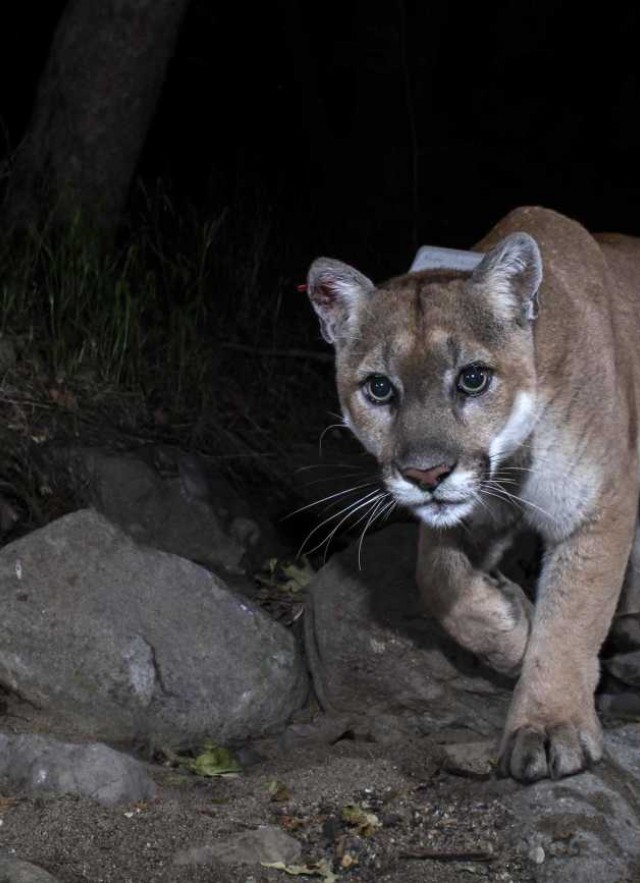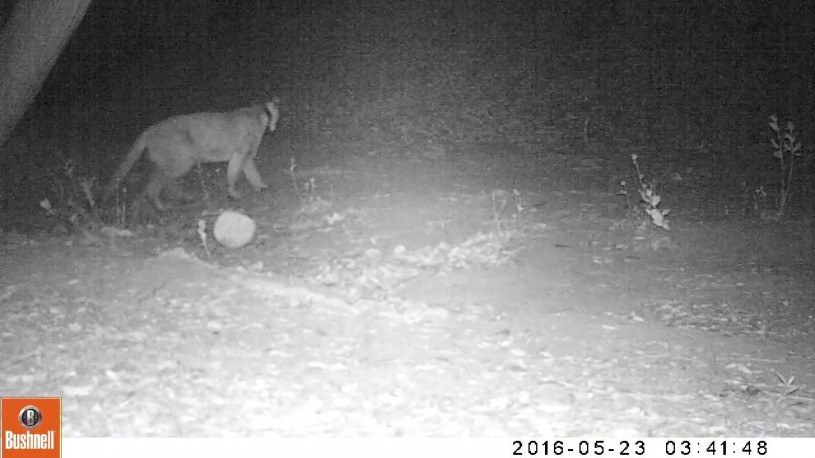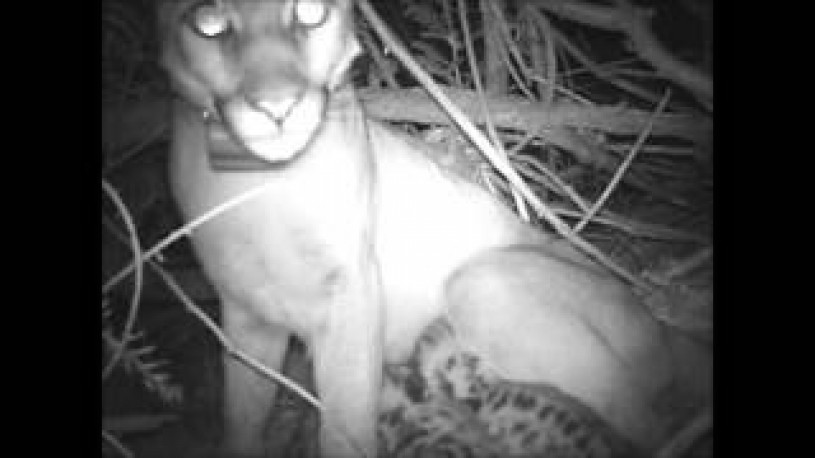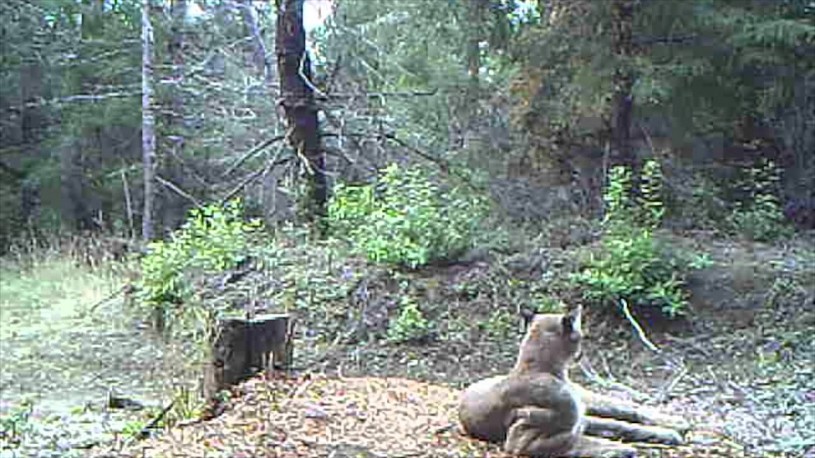The Hart Museum remains closed. Los Angeles County has approved a plan to transfer the William S. Hart Museum and Park from the County to the City of Santa Clarita.
The Sound of Our Griffith Park Mountain Lion: P-22 and the Mysteries of Puma Communication
What comes to mind when you imagine the call of P-22, L.A.'s famous urban mountain lion?

Originally published in 2019
What comes to mind when you imagine the call of P-22, L.A.'s famous urban mountain lion (Puma concolor)? Do you imagine a roar or violent hiss? If so, you are not alone because that is what people most often see and hear in the movies.
However, a recent video of P-22 vocalizing (first ever!) paints a different picture. The video supports recent cutting edge research suggesting that puma communication is more complex than we once thought. As we prepare to celebrate our beloved Griffith Park denizen on P-22 Day, the rare footage reminds us how much we still have to learn about mountain lions, including L.A.’s most famous mountain lion.

First and only footage of P-22 making a vocalization. (Turn your volume up or else you'll miss it!)
Whenever a mountain lion is featured in a movie, the special effects crew usually use the roar of a big cat (animals in the Panthera genus--i.e. lions, tigers, jaguars, and panthers) or they use the call of an agitated mountain lion, which isn’t surprising, because its main objective is to entertain rather than accurately portray puma behavior. Using the roar of a big cat is inaccurate because only big cats, with their specialized larynx and flexible hyoid bone, can roar but can’t purr.[Exception: Snow leopards (Panthera uncia) are big cats that can’t roar but can purr]. All other cats, including mountain lions, purr but can’t roar. The larynx of a small cat is ossified (hardened) and has special folds that allow it to produce the purring sound when it is inhaling and exhaling. Although mountain lions can make agitated calls, they more frequently use other methods of communication. In fact, the most common mountain lion communications don’t involve sound at all!
**Fun fact: Cheetahs and mountain lions belong to the puma lineage and are not closely related to other large cats but instead are considered oversized small cats. **
Mountain lions, like many other cats rely on stealth for survival. Remaining out of sight and out of mind is important not only to hide from potential threats like competitors, but also because mountain lions--like most cats, including your pampered pet cat--are ambush predators. Instead of chasing down prey from long distances, ambush predators are expert stalkers and conserve their energy and minimize injury risk by waiting for the victim to get close enough to improve the probability of a successful kill. Mountain lions are equipped with night vision as well as retractable claws that are concealed in padded paws. Additionally they are instructed by their experienced mothers on how to sneak up on prey and roam around unnoticed in the cover of darkness, while remaining still during the day.
Mountain lions are generally difficult to study because they are not only nocturnal but also occur at low densities due to their being solitary and territorial. Mountain lions are especially territorial in the fragmented landscape of Los Angeles because there is very little suitable habitat to go around, so direct communication can be very risky. Indirect communications between pumas come in the form of olfactory and visual cues such as urine or fecal deposits, scratch marks on trees, or a combination (Allen et al. 2015). Adult males, especially dominant males usually delineate territory boundaries, display dominance, or express sexual status using scrapes. Scrapes are produced primarily by males when the puma digs into the ground with its back feet (only), just like P-22 in the video below.

This is the only footage of P-22 digging a scrape to mark his territory.
Prior to the invention of camera traps, scientists were only able to study puma communication based on indirect cues, knowing that they regularly miss a totally different form of communication, vocalization. Even expert trackers almost never observe the cats vocalizations, limiting puma vocal communication research to captive pumas.
Fortunately, relatively recent advancements in camera trap technology such as high definition (HD) camera trap video has allowed biologists to study mountain lion communication in the wild, including vocal communication. Max Allen and UC Santa Cruz researchers executed a new study (Allen et al., In Press) using camera trap video technology to record the different types and functions of mountain lion vocalization. Allen and his colleagues identified five calls that fell under two categories: “attention attracting” and “contact and alarm calls.” “Attention attracting” calls are primarily used by females to let to males know they are ready to mate or by kittens calling to receive food from their mothers.

Kittens nursing and calling to receive more food in Northern California. Video credit: Max Allen
“Contact and alarm calls,” are typically used to communicate with nearby mountain lions. Similar to male-dominated scrapes, males and females differentiate in the vocalizations they primarily use. For instance females predominantly caterwaul, which alert males in the area that they are available to mate.

Female caterwauling to attract a male in Northern California. Video credit: Max Allen
But if vocalizations are motivated by territoriality and mating, why would P-22, an isolated mountain lion occupying the smallest and most urban territory ever recorded for a mountain lion, make a vocalization?
The first clue to the mystery is his long track record of exhibiting natural behavior identical to that of his more rural counterparts. He has actively avoided people and pets and seems to shy away from heavily trafficked areas. He also has been documented exhibiting territorial behavior such as boundary patrol of his territory and scent marking. The type of call he has been recorded using mostly resembles a chirp/whistle, which is a short, high-pitched call that is categorized as a contact call. The high pitch allows the sound to travel well through woodland habitat. Any interpretation of his behavior is, however, somewhat subjective. Allen and his colleagues feel they are only scratching the surface of puma communication research and that there are many more than five vocalizations that they have identified.
P-22’s regular territorial and natural behavior suggests that he hasn’t given up hope that a female will someday enter his territory and/or he hasn’t put his guard down in case another male encroaches on his turf. What it tells me is that his retention of natural puma behavior such as patience as an ambush predator, territoriality, and lack of habituation to humans may be keys for survival in an isolated and urban environment. The fact that P-22 hasn’t given up on encountering another puma someday means he hasn’t given up on connectivity. Perhaps Angelenos and conservationists can use this as motivation to tackle the formidable barriers to improving habitat connectivity, thus ensuring a future for L.A. area mountain lions.
References
Allen, M., Y. Wang, and C. Wilmers. In Press. Exploring the adaptive significance of five types of puma (Puma concolor) vocalizations. Canadian Field-Naturalist.
Allen, M.L., H.U. Wittmer, P. Houghtaling, J. Smith, L.M. Elbroch, and C.C. Wilmers. 2015. The role of scent marking in mate selection by female pumas (Puma concolor). PLoS One 10: e0139087.
Elbroch, M. and Rinehart, K. 2011. Peterson Reference Guides to Behavior of North American Mammals. Houghton Mifflin Harcourt Publishing Company, New York, New York. pp. 72.
Hunter, L., and Barrett, P. 2015. Wild cats of the world. Bloomsbury Natural History, an imprint of Bloomsbury Publishing Plc. London; New York. pp. 9.